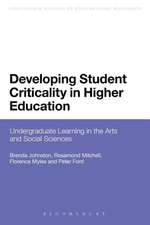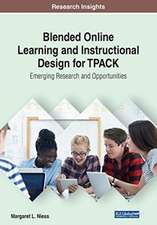Second Language Learning Theories: Fourth Edition
Autor Rosamond Mitchell, Florence Myles, Emma Marsdenen Limba Engleză Paperback – 29 ian 2019
The book covers all the main theoretical perspectives currently active in SLA and sets each chapter within a broader framework. Each chapter examines the claims and scope of each theory and how each views language, the learner and the acquisition process, supplemented by summaries of key studies and data examples from a variety of languages. Chapters end with an evaluative summary of the theories discussed. Key features to this fourth edition include updated accounts of developments in cognitive approaches to second language (L2) learning, the implications of advances in generative linguistics and the "social turn" in L2 research, with re-worked chapters on functional, sociocultural and sociolinguistic perspectives, and an entirely new chapter on theory integration, in addition to updated examples using new studies.
Second Language Learning Theories continues to be an essential resource for graduate students in second language acquisition.
| Toate formatele și edițiile | Preț | Express |
|---|---|---|
| Paperback (1) | 343.86 lei 22-36 zile | +31.08 lei 6-12 zile |
| Taylor & Francis – 29 ian 2019 | 343.86 lei 22-36 zile | +31.08 lei 6-12 zile |
| Hardback (1) | 993.62 lei 43-57 zile | |
| Taylor & Francis – 21 ian 2019 | 993.62 lei 43-57 zile |
Preț: 343.86 lei
Nou
Puncte Express: 516
Preț estimativ în valută:
65.81€ • 68.56$ • 54.72£
65.81€ • 68.56$ • 54.72£
Carte disponibilă
Livrare economică 20 ianuarie-03 februarie 25
Livrare express 04-10 ianuarie 25 pentru 41.07 lei
Preluare comenzi: 021 569.72.76
Specificații
ISBN-13: 9781138671416
ISBN-10: 113867141X
Pagini: 462
Ilustrații: 59 Tables, black and white; 33 Line drawings, black and white; 33 Illustrations, black and white
Dimensiuni: 152 x 229 x 30 mm
Greutate: 0.67 kg
Ediția:4 ed
Editura: Taylor & Francis
Colecția Routledge
Locul publicării:Oxford, United Kingdom
ISBN-10: 113867141X
Pagini: 462
Ilustrații: 59 Tables, black and white; 33 Line drawings, black and white; 33 Illustrations, black and white
Dimensiuni: 152 x 229 x 30 mm
Greutate: 0.67 kg
Ediția:4 ed
Editura: Taylor & Francis
Colecția Routledge
Locul publicării:Oxford, United Kingdom
Cuprins
Table of Contents
List of illustrations
Acknowledgements
Preface
Subject index
Name index
List of illustrations
Acknowledgements
Preface
- Second language learning: key concepts and issues
- Introduction
- What makes for a good theory?
- Views on the nature of language
- The language learning process
- Views of the language learner
- Links with social practice
- Conclusion
- References
- The recent history of second language learning research
- Introduction
- The 1950s and 1960s
- The 1970s
- The 1980s: a turning point
- Continuities and new themes
- Second language learning timeline
- References
- Linguistics and language learning: the Universal Grammar approach
- Introduction
- Why a Universal Grammar?
- What does Universal Grammar consist of?
- Universal Grammar and L1 acquisition
- Universal Grammar and L2 acquisition
- Evaluation of Universal Grammar-based approaches to L2 acquisition
- References
- Cognitive approaches to second language learning (1): general learning mechanisms
- Introduction
- Input-based emergentist perspectives
- Processing-based perspectives
- Evaluation of general cognitive approaches
- References
- Cognitive approaches to second language learning (2): Memory systems, explicit knowledge, and skill learning
- Introduction
- Memory systems and their role in L2 learning
- Explicit knowledge, information processing and skill acquisition
- Awareness and attention in L2 acquisition
- Working memory and L2 learning
- Evaluation of cognitive approaches (2): memory systems, explicit knowledge, and skill learning
- References
- Interaction in second language learning
- Introduction
- The revised Interaction Hypothesis (Long, 1996): an appeal to cognitive theory
- Negotiation of meaning and the learning of target L2 structures and vocabulary
- The role of feedback during oral interaction
- The problem of "noticing"
- L2 development in computer-mediated interaction
- Characteristics of learners and of tasks
- Evaluation
- References
- Meaning-based perspectives on second language learning
- Introduction
- Early functionalist studies of second language learning
- Functionalism beyond the case study: the "learner varieties" approach
- "Time talk": developing the means to talk about time
- The Aspect Hypothesis
- Cognitive linguistics and "thinking for speaking"
- Second language pragmatics
- Evaluation
- References
- Sociocultural perspectives on second language learning
- Introduction
- Sociocultural theory
- Applications of sociocultural theory to second language learning
- Evaluation
- References
- Sociolinguistic perspectives
- Introduction
- Sociolinguistically driven variability in second language use
- Second language socialization
- Conversation analysis and second language learning
- Communities of practice and situated learning
- The language learner as social being: L2 identity, agency and investment
- Evaluation: the scope and achievement of sociolinguistic inquiry
- References
- Integrating theoretical perspectives on second language learning
10.1. Introduction
10.2. The MOGUL framework
10.3. Dynamic Systems Theory (DST)
10.4. Conclusion
10.5. References - Conclusion
- One theory or many?
- Main achievements of second language learning research
- Future directions
- Second language research and language education
Subject index
Name index
Notă biografică
Rosamond Mitchell is Emeritus Professor of Applied Linguistics at the University of Southampton, UK.
Florence Myles is Professor of Second Language Acquisition at the University of Essex, UK.
Emma Marsden is Professor at the Centre for Research into Language Learning and Use at the University of York, UK.
Florence Myles is Professor of Second Language Acquisition at the University of Essex, UK.
Emma Marsden is Professor at the Centre for Research into Language Learning and Use at the University of York, UK.
Descriere
Written by a team of leading experts working in different SLA specialisms, this fourth edition of Second Language Learning Theories a clear and concise introduction to the main theories of second language acquisition (SLA) from multiple perspectives, comprehensively updated to reflect the very latest developments SLA research.












